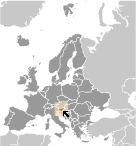World Atlas: Slovenia. On this page you can see the map, country flag and many detailed information about the people, history and economy of Slovenia.

Here you can find online selected information about the geography, inhabitants, government, economy and history of Slovenia. Included are selected statistics, an overview map and the detailed map of Slovenia. But let's start with the flag of Slovenia here:
Slovenia - Overview:
What you should know about Slovenia? Let's start with this: The Slovene lands were part of the Austro-Hungarian Empire until the latter's dissolution at the end of World War I. In 1918, the Slovenes joined the Serbs and Croats in forming a new multinational state, which was named Yugoslavia in 1929. After World War II, Slovenia became a republic of the renewed Yugoslavia, which though communist, distanced itself from Moscow's rule. Dissatisfied with the exercise of power by the majority Serbs, the Slovenes succeeded in establishing their independence in 1991 after a short 10-day war. Historical ties to Western Europe, a strong economy, and a stable democracy have assisted in Slovenia's transformation to a modern state. Slovenia acceded to both NATO and the EU in the spring of 2004; it joined the euro zone and the Schengen zone in 2007.
Geography of Slovenia
 Where on the globe is Slovenia? The location of this country is south Central Europe, Julian Alps between Austria and Croatia. Total area of Slovenia is 20,273 sq km, of which 20,151 sq km is land. So this is not a large country. How could we describe the terrain of the country? This way: a short southwestern coastal strip of Karst topography on the Adriatic; an alpine mountain region lies adjacent to Italy and Austria in the north; mixed mountains and valleys with numerous rivers to the east. The lowest point of Slovenia is Adriatic Sea 0 m, the highest point Triglav 2,864 m. And the climate is Mediterranean climate on the coast, continental climate with mild to hot summers and cold winters in the plateaus and valleys to the east.
Where on the globe is Slovenia? The location of this country is south Central Europe, Julian Alps between Austria and Croatia. Total area of Slovenia is 20,273 sq km, of which 20,151 sq km is land. So this is not a large country. How could we describe the terrain of the country? This way: a short southwestern coastal strip of Karst topography on the Adriatic; an alpine mountain region lies adjacent to Italy and Austria in the north; mixed mountains and valleys with numerous rivers to the east. The lowest point of Slovenia is Adriatic Sea 0 m, the highest point Triglav 2,864 m. And the climate is Mediterranean climate on the coast, continental climate with mild to hot summers and cold winters in the plateaus and valleys to the east.
Inhabitants of Slovenia
Let's take a look how many people live in Slovenia. The number is: 1,972,126 (July 2017 est.). So not so many people live here. Who lives here? Slovene 83.1%, Serb 2%, Croat 1.8%, Bosniak 1.1%, other or unspecified 12% (2002 census). What are the languages in Slovenia? Slovenian (official) 91.1%, Serbo-Croatian 4.5%, other or unspecified 4.4%, Italian (official, only in municipalities where Italian national communities reside), Hungarian (official, only in municipalities where Hungarian national communities reside) (2002 census). And the religions: Catholic 57.8%, Muslim 2.4%, Orthodox 2.3%, other Christian 0.9%, unaffiliated 3.5%, other or unspecified 23%, none 10.1% (2002 census). How old are the people in average? 44.5 years. We have to add that this number is the median - so one half of the people is older than this, one half is younger. And what is their life expectancy (at birth)? This: 78.3 years. Where the people live in Slovenia? Here: a fairly even distribution throughout most of the country, with urban areas attracting larger and denser populations; pockets in the mountainous northwest exhibit less density than elsewhere. The major urban areas of Slovenia are: Ljubljana (capital) 279,000 (2014).
Government and Economy of Slovenia
The capital of Slovenia is Ljubljana and the government type parliamentary republic. Let's take a look at the administrative divisions - 201 municipalities (obcine, singular - obcina) and 11 urban municipalities (mestne obcine, singular - mestna obcina). Regarding the economy of Slovenia, important industrial products are ferrous metallurgy and aluminum products, lead and zinc smelting; electronics (including military electronics), trucks, automobiles, electric power equipment, wood products, textiles, chemicals, machine tools. Important agricultural products are hops, wheat, coffee, corn, apples, pears; cattle, sheep, poultry. The most important export commodities are manufactured goods, machinery and transport equipment, chemicals, food and the most important export partners are Germany 19.3%, Italy 10.4%, Austria 7.5%, Croatia 7.3%, Hungary 4.4%, France 4.1% (2016). The most important import commodities are machinery and transport equipment, manufactured goods, chemicals, fuels and lubricants, food and the most important import partners are Germany 16.8%, Italy 13.5%, Austria 9.9%, Croatia 5.5%, China 4.8%, Turkey 4.4% (2016). How rich is Slovenia and how rich are people in this country? The most important number here is GDP per capita (PPP): $34,100 (2017 est.). This means the living standards are good here. Let's add that this means Gross Domestic Product per person, which is recalculated with respect to the relative cost of local goods and services. And one more important number - population below poverty line: 14.3% (2015 est.).